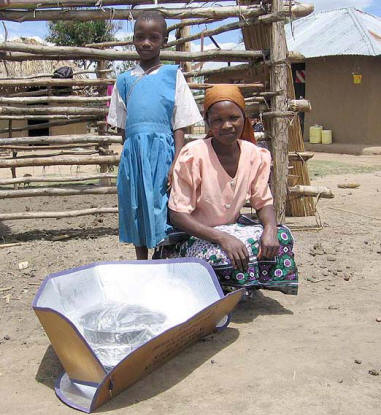
|
March 2008 Volume 14, Number 1
|
Back Issues:
http://solarcooking.org/docs.htm |
[Editor's note: "News you send" is compiled by Tom Sponheim, Solar Cookers International's information exchange specialist. E-mail your news items to info@solarcookers.org or mail to Kevin Porter, Solar Cookers International, 1919 21st Street #101, Sacramento, California 95811-6827, USA. We want to hear from you — especially if your program is growing or if your work has not been featured in the Solar Cooker Review before. Please include your contact information. Submissions are subject to editing if printed.]
Kenya / United States
 Princeton University’s informal motto ends “… in the Service of All
Nations,” an ideal being pursued by two undergraduate engineering students
spreading solar cooking skills in
Kenya and beyond. In 2005,
Ishani Sud and
Julianne Davis traveled to Laikipia, Kenya to introduce solar box cookers
designed by Sud and classmate
Lauren Wang, and to build solar cookers with
appropriate local materials. To facilitate technology transfer, Sud and Davis
chose to work with primary school students and hold special events to spark
interest with parents. Covering topics in science, conservation and renewable
energy, Davis taught elementary students in the Mpala Research Centre school,
while Sud taught middle school students at the Lekiji public school. Lessons for
the older students included a series of experiments, such as comparing black
metal and white metal temperatures when exposed to sun, that helped them
understand how solar cookers work and select appropriate construction materials.
The locally available materials chosen for these cookers were Cyprus wood,
aluminum sheet metal, glass, and black cloth as a box liner to absorb sunlight.
Time was set aside each week for students to work on constructing their own
solar cooker. More recently, Sud has returned to Kenya to continue her work on
the project, and has launched a similar project at the Aang Serian school in
Monduli, Tanzania.
Princeton University’s informal motto ends “… in the Service of All
Nations,” an ideal being pursued by two undergraduate engineering students
spreading solar cooking skills in
Kenya and beyond. In 2005,
Ishani Sud and
Julianne Davis traveled to Laikipia, Kenya to introduce solar box cookers
designed by Sud and classmate
Lauren Wang, and to build solar cookers with
appropriate local materials. To facilitate technology transfer, Sud and Davis
chose to work with primary school students and hold special events to spark
interest with parents. Covering topics in science, conservation and renewable
energy, Davis taught elementary students in the Mpala Research Centre school,
while Sud taught middle school students at the Lekiji public school. Lessons for
the older students included a series of experiments, such as comparing black
metal and white metal temperatures when exposed to sun, that helped them
understand how solar cookers work and select appropriate construction materials.
The locally available materials chosen for these cookers were Cyprus wood,
aluminum sheet metal, glass, and black cloth as a box liner to absorb sunlight.
Time was set aside each week for students to work on constructing their own
solar cooker. More recently, Sud has returned to Kenya to continue her work on
the project, and has launched a similar project at the Aang Serian school in
Monduli, Tanzania.
Mali
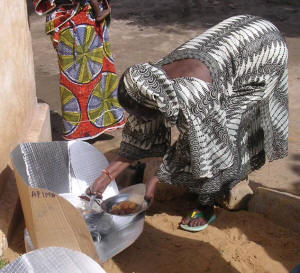 The Association of Handicapped Women (AMAFH) continues to arrange solar
cooker training for its members in Bamako, with organizational support from the
Association of Women Engineers (AFIMA) and financial assistance from Dutch
foundation KoZon. In
2006, AMAFH taught 60 deaf and hard-of-hearing women how to use a
CooKit solar cooker
during a 2-day training. In a follow-up visit months later, at a school for deaf
children, the women cooked a delicious solar feast. Fifty women with leprosy were trained in
early 2007.
The Association of Handicapped Women (AMAFH) continues to arrange solar
cooker training for its members in Bamako, with organizational support from the
Association of Women Engineers (AFIMA) and financial assistance from Dutch
foundation KoZon. In
2006, AMAFH taught 60 deaf and hard-of-hearing women how to use a
CooKit solar cooker
during a 2-day training. In a follow-up visit months later, at a school for deaf
children, the women cooked a delicious solar feast. Fifty women with leprosy were trained in
early 2007.
 With the loss of nerve sensation caused by the disease, traditional
open fire cooking can be dangerous for these women because they can unknowingly
get burned. Another benefit is that the women have increased status in the
community because they now know something that most don’t: how to cook food with
the sun. They said that with the CooKit they can prepare special recipes for
their husbands, prepare groundnuts for their children, and even sell
solar-cooked meat in the market. One remarkable woman,
Mariam Toure, has lost
all but one finger. Yet, she already has plans to lead a training early this
year for another group of women with the disease. AMAFH also led a 2-day solar cooking workshop
for 20 mentally disabled women in late 2007, which was well received. Contact:
Wietske Jongbloed, Stichting KoZon, Hollandseweg 384, 6705 BE Wageningen,
Netherlands. Tel: 31-317412370, e-mail:
wietske-jongbloed@tele2.nl, Web:
www.kozon.org
With the loss of nerve sensation caused by the disease, traditional
open fire cooking can be dangerous for these women because they can unknowingly
get burned. Another benefit is that the women have increased status in the
community because they now know something that most don’t: how to cook food with
the sun. They said that with the CooKit they can prepare special recipes for
their husbands, prepare groundnuts for their children, and even sell
solar-cooked meat in the market. One remarkable woman,
Mariam Toure, has lost
all but one finger. Yet, she already has plans to lead a training early this
year for another group of women with the disease. AMAFH also led a 2-day solar cooking workshop
for 20 mentally disabled women in late 2007, which was well received. Contact:
Wietske Jongbloed, Stichting KoZon, Hollandseweg 384, 6705 BE Wageningen,
Netherlands. Tel: 31-317412370, e-mail:
wietske-jongbloed@tele2.nl, Web:
www.kozon.org
 Longtime solar cooker builder and promoter
Gnibouwa Diassana
reports that 40 solar box cookers have been assembled and distributed to
villagers in Nioro du Sahel, near the border with
Mauritania. Nioro du Sahel
suffers from an acute shortage of firewood for cooking. Diassana says that a
special cooking vessel has been made to accommodate the local staple of couscous
with millet or corn. Contact: Gnibouwa Diassana by e-mail:
gnibouwa_diassana@wvi.org
Longtime solar cooker builder and promoter
Gnibouwa Diassana
reports that 40 solar box cookers have been assembled and distributed to
villagers in Nioro du Sahel, near the border with
Mauritania. Nioro du Sahel
suffers from an acute shortage of firewood for cooking. Diassana says that a
special cooking vessel has been made to accommodate the local staple of couscous
with millet or corn. Contact: Gnibouwa Diassana by e-mail:
gnibouwa_diassana@wvi.org
Sudan / Kenya
 Louise
Meyer reports on a group of internally displaced persons that are students at
the Culinary Institute of Africa. As part of their curriculum they are learning
how to solar cook. Meyer sent photographs of several students taking “Masters of
Solar Cooking” classes at the Institute’s school in Juba,
Sudan. Based in Lokichoggio,
Kenya, the non-profit
Culinary Institute of Africa is a community service division of the AFEX Group,
which provides a number of management and catering services to camps throughout
Kenya, Sudan, and elsewhere. The Institute began in 2004 when
Terry Light, chief
operating officer of AFEX, asked
Nancy Crooks to train local Turkana with skills
that could gain them employment at various camps and other institutions in the
region. With technical assistance from
Solar Cookers International (SCI), Crooks
was able to incorporate solar cooker use and construction into the curriculum.
The Institute offers an accredited, professional culinary education leading to a
diploma in food production. SCI also provided training services and helped
Crooks secure funding from the Lift Up Africa organization for a solar cooker
project to teach Turkana women how to make and use solar cookers, heat-retention
devices, and
Water Pasteurization Indicators (WAPIs), as well as start a small
solar cooker shop. Contact:
Culinary Institute of Africa, P.O. Box 24598, 00502
Nairobi, Kenya. Tel: (254-20) 3878313 or 3864191, fax: (254-20) 3002899, e-mail:
ci@afexgroup.com, Web:
www.afexgroup.com/culinary.php;
Nancy Crooks, Tel: 020 418 3413 or 0722 707 799, e-mail:
hhc@africaonline.co.ke
Louise
Meyer reports on a group of internally displaced persons that are students at
the Culinary Institute of Africa. As part of their curriculum they are learning
how to solar cook. Meyer sent photographs of several students taking “Masters of
Solar Cooking” classes at the Institute’s school in Juba,
Sudan. Based in Lokichoggio,
Kenya, the non-profit
Culinary Institute of Africa is a community service division of the AFEX Group,
which provides a number of management and catering services to camps throughout
Kenya, Sudan, and elsewhere. The Institute began in 2004 when
Terry Light, chief
operating officer of AFEX, asked
Nancy Crooks to train local Turkana with skills
that could gain them employment at various camps and other institutions in the
region. With technical assistance from
Solar Cookers International (SCI), Crooks
was able to incorporate solar cooker use and construction into the curriculum.
The Institute offers an accredited, professional culinary education leading to a
diploma in food production. SCI also provided training services and helped
Crooks secure funding from the Lift Up Africa organization for a solar cooker
project to teach Turkana women how to make and use solar cookers, heat-retention
devices, and
Water Pasteurization Indicators (WAPIs), as well as start a small
solar cooker shop. Contact:
Culinary Institute of Africa, P.O. Box 24598, 00502
Nairobi, Kenya. Tel: (254-20) 3878313 or 3864191, fax: (254-20) 3002899, e-mail:
ci@afexgroup.com, Web:
www.afexgroup.com/culinary.php;
Nancy Crooks, Tel: 020 418 3413 or 0722 707 799, e-mail:
hhc@africaonline.co.ke
Tanzania / United States
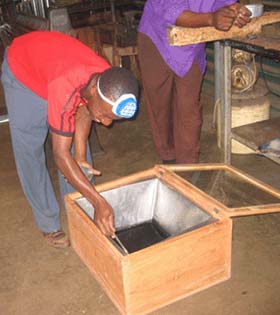 The
Okemos, Michigan (USA) nonprofit organization
Solar Circle continues its efforts
to make solar cooking an option for women in Tanzania. Solar Circle works with
local artisans to manufacture solar box cookers from Cyprus wood, aluminum
printing plates, glass, used rubber, and other materials available in Tanzania.
However, these cookers cost $70 or more to build, and are heavily subsidized to
be affordable. Solar Circle has partnered with engineering students at Michigan
State University (MSU) to design lighter, less expensive models that can still
be made with local materials. Last year, professor Craig
Somerton took nine of the students to Masasi, Tanzania to work with Brother
Yohannes Mango and his team of artisans at the Benedictine Abbey in Ndanda.
According to the Solar Circle Web site, the “students came armed with sound
scientific theories on the behavior of light and heat, and met up with artisans
experienced in constructing solar ovens. They worked together to test and
improve the ovens. The artisans learned some theory, the students learned some
practicalities of building without … power tools and computer enhancements.” The
students also spent time teaching the local population how to use the solar
cookers. The on-line journal MSU Today International reported that, while the
students were in Masasi, professor Brian Thompson spent time in Dar es Salaam
and Morogoro working “to make the use of solar ovens a nationwide reality by
networking with numerous agencies before formulating a broad initiative”
involving businesses, governmental entities, and schools. The Shell foundation,
for example, has since funded a solar cooking workshop in Morogoro at
Sokoine
University. As noted on the Solar Circle Web site, many agency representatives,
entrepreneurs and policy makers attended and “gathered to learn about solar
cooking and brainstorm best ways to promulgate solar cooking in Tanzania.” A
number of solar cookers were on display, including models from South Africa,
Holland, and the United States. Contact: Solar Circle, 4709 Woodcraft, Okemos,
Michigan 48864, USA. Tel: 517-349-4531, e-mail:
info@solar-circle.org, Web:
www.solar-circle.org
The
Okemos, Michigan (USA) nonprofit organization
Solar Circle continues its efforts
to make solar cooking an option for women in Tanzania. Solar Circle works with
local artisans to manufacture solar box cookers from Cyprus wood, aluminum
printing plates, glass, used rubber, and other materials available in Tanzania.
However, these cookers cost $70 or more to build, and are heavily subsidized to
be affordable. Solar Circle has partnered with engineering students at Michigan
State University (MSU) to design lighter, less expensive models that can still
be made with local materials. Last year, professor Craig
Somerton took nine of the students to Masasi, Tanzania to work with Brother
Yohannes Mango and his team of artisans at the Benedictine Abbey in Ndanda.
According to the Solar Circle Web site, the “students came armed with sound
scientific theories on the behavior of light and heat, and met up with artisans
experienced in constructing solar ovens. They worked together to test and
improve the ovens. The artisans learned some theory, the students learned some
practicalities of building without … power tools and computer enhancements.” The
students also spent time teaching the local population how to use the solar
cookers. The on-line journal MSU Today International reported that, while the
students were in Masasi, professor Brian Thompson spent time in Dar es Salaam
and Morogoro working “to make the use of solar ovens a nationwide reality by
networking with numerous agencies before formulating a broad initiative”
involving businesses, governmental entities, and schools. The Shell foundation,
for example, has since funded a solar cooking workshop in Morogoro at
Sokoine
University. As noted on the Solar Circle Web site, many agency representatives,
entrepreneurs and policy makers attended and “gathered to learn about solar
cooking and brainstorm best ways to promulgate solar cooking in Tanzania.” A
number of solar cookers were on display, including models from South Africa,
Holland, and the United States. Contact: Solar Circle, 4709 Woodcraft, Okemos,
Michigan 48864, USA. Tel: 517-349-4531, e-mail:
info@solar-circle.org, Web:
www.solar-circle.org
ASIA AND OCEANIA
India / United States
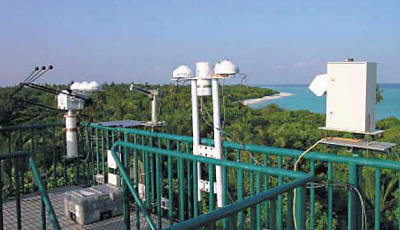 A March 2007 white paper — by Dr.
Veerabhadran Ramanathan, distinguished
professor of climate and atmospheric sciences at the Scripps Institution of
Oceanography, University of California, San Diego (USA), and Dr.
Kalpana
Balakrishnan, head of the Environmental Health Engineering department at Sri
Ramachandra University, Chennai, India — outlines a project to reduce air
pollution and global warming with community-wide use of solar cookers and
improved biofuel cooking devices. The authors provide many referenced details
about the negative health and environmental impacts of biomass burning and
biofuel cooking, which they say are “the major sources of elemental carbon (EC)
in India and other developing nations.” Carbon dioxide and EC, or soot, are the
“two largest agents of global warming.” In India, where a reported 90 percent of
cooking is done over wood- and dung-fueled fires, several studies have
documented that “indoor air pollution leads to 400,000-550,000 premature deaths
… from lower respiratory infections and chronic obstructive pulmonary disease. …
The burden falls disproportionately on women and children, who inhale soot and
other particles from smoke released by the burning of biofuels.” This soot
combines with outdoor air pollution to form atmospheric brown clouds (ABCs) that
“envelope most of India and the Indian Ocean … [leading] to a large reduction of
sunlight at the ground and … atmospheric solar heating.” Since EC and other
particles in ABCs have relatively short lifetimes compared to carbon dioxide in
the atmosphere, the authors believe global EC reductions can “give us a decade
or two to come up with viable and sustainable alternatives for fossil fuel
combustion.” In the proposed “Project Surya,” solar cookers will be distributed
in 65 villages in the Periyar PURA region in the Thanjavur and Pudukkottai
districts of Tamil Nadu, benefiting approximately 6,500 households that
currently use about 5 kilograms of firewood per day. Other fuel-efficient
cooking devices will be available for use at night or on inclement days. The
region has a strong base of local nongovernmental organizations and social
networks, including women’s self-help groups, that will be useful for project
implementation. Input and feedback from the communities will be gathered and
used in a number of ways. Surveys of eating habits and estimated cooking fuel
requirements will be conducted. Meetings with local leaders will be used to
demonstrate a range of solar cooking technologies and to solicit feedback on
their suitability and probability of acceptance in the communities at large.
Educational outreach and incentives will be used to maximize use of clean
cooking technologies. Installation, operation and maintenance training programs
will be offered for those interested. Data collection
will begin six months before the project launch, and will continue for at least
a year after. Using special instrument towers, researchers will measure
concentrations of particulates and soot content, as well as surface solar
radiation. If feasible, indoor air pollution will be monitored using special
equipment installed in select homes. (Alternatively, a mobile laboratory may be
used.) Children will be involved as well, collecting data on cooking fuel use
and cooking times, among other things. This data will help quantify the
reduction in biofuel use and soot emissions. Though the authors state “it is
difficult and costly to [accurately] quantify the disease burden due to indoor
air pollution,” they “propose to build the evidence for expected health
improvements … through documentation of exposure reduction and subsequently
through reduction in incidence and severity of diseases.” The stated goals of
the project, in order of importance, are: 1. To eliminate the detrimental health
effects of indoor smoke; 2. To reduce the negative effects of EC in ABCs on the
summer monsoon rainfall, Himalyan glacier retreat and agriculture; 3. To
mitigate the global warming effects of CO2 and elemental carbon. Contact:
Vanessa A. Balta Cook, Center for Clouds, Chemistry and Climate at SIO-UCSD.
Tel: 858-534-8815, e-mail: vbaltacook@ucsd.edu, Web:
http://www-ramanathan.ucsd.edu/ProjectSurya.html
A March 2007 white paper — by Dr.
Veerabhadran Ramanathan, distinguished
professor of climate and atmospheric sciences at the Scripps Institution of
Oceanography, University of California, San Diego (USA), and Dr.
Kalpana
Balakrishnan, head of the Environmental Health Engineering department at Sri
Ramachandra University, Chennai, India — outlines a project to reduce air
pollution and global warming with community-wide use of solar cookers and
improved biofuel cooking devices. The authors provide many referenced details
about the negative health and environmental impacts of biomass burning and
biofuel cooking, which they say are “the major sources of elemental carbon (EC)
in India and other developing nations.” Carbon dioxide and EC, or soot, are the
“two largest agents of global warming.” In India, where a reported 90 percent of
cooking is done over wood- and dung-fueled fires, several studies have
documented that “indoor air pollution leads to 400,000-550,000 premature deaths
… from lower respiratory infections and chronic obstructive pulmonary disease. …
The burden falls disproportionately on women and children, who inhale soot and
other particles from smoke released by the burning of biofuels.” This soot
combines with outdoor air pollution to form atmospheric brown clouds (ABCs) that
“envelope most of India and the Indian Ocean … [leading] to a large reduction of
sunlight at the ground and … atmospheric solar heating.” Since EC and other
particles in ABCs have relatively short lifetimes compared to carbon dioxide in
the atmosphere, the authors believe global EC reductions can “give us a decade
or two to come up with viable and sustainable alternatives for fossil fuel
combustion.” In the proposed “Project Surya,” solar cookers will be distributed
in 65 villages in the Periyar PURA region in the Thanjavur and Pudukkottai
districts of Tamil Nadu, benefiting approximately 6,500 households that
currently use about 5 kilograms of firewood per day. Other fuel-efficient
cooking devices will be available for use at night or on inclement days. The
region has a strong base of local nongovernmental organizations and social
networks, including women’s self-help groups, that will be useful for project
implementation. Input and feedback from the communities will be gathered and
used in a number of ways. Surveys of eating habits and estimated cooking fuel
requirements will be conducted. Meetings with local leaders will be used to
demonstrate a range of solar cooking technologies and to solicit feedback on
their suitability and probability of acceptance in the communities at large.
Educational outreach and incentives will be used to maximize use of clean
cooking technologies. Installation, operation and maintenance training programs
will be offered for those interested. Data collection
will begin six months before the project launch, and will continue for at least
a year after. Using special instrument towers, researchers will measure
concentrations of particulates and soot content, as well as surface solar
radiation. If feasible, indoor air pollution will be monitored using special
equipment installed in select homes. (Alternatively, a mobile laboratory may be
used.) Children will be involved as well, collecting data on cooking fuel use
and cooking times, among other things. This data will help quantify the
reduction in biofuel use and soot emissions. Though the authors state “it is
difficult and costly to [accurately] quantify the disease burden due to indoor
air pollution,” they “propose to build the evidence for expected health
improvements … through documentation of exposure reduction and subsequently
through reduction in incidence and severity of diseases.” The stated goals of
the project, in order of importance, are: 1. To eliminate the detrimental health
effects of indoor smoke; 2. To reduce the negative effects of EC in ABCs on the
summer monsoon rainfall, Himalyan glacier retreat and agriculture; 3. To
mitigate the global warming effects of CO2 and elemental carbon. Contact:
Vanessa A. Balta Cook, Center for Clouds, Chemistry and Climate at SIO-UCSD.
Tel: 858-534-8815, e-mail: vbaltacook@ucsd.edu, Web:
http://www-ramanathan.ucsd.edu/ProjectSurya.html
Nepal
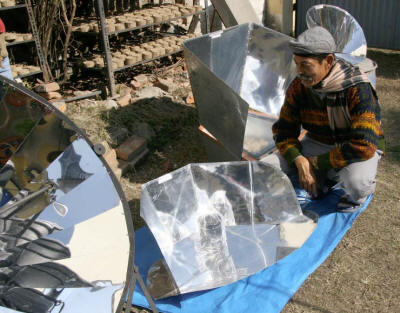 The BBC’s annual World Challenge competition
honors individuals and organizations that make a difference through enterprise
and innovation at a grassroots level. The top 12 projects were promoted on the
television program BBC World and in Newsweek magazine, followed by a public
voting period. Solar cooker promoter
Sanu Kaji Shrestha reports that his
organization, Foundation for Sustainable Technologies (FoST), was a top three
finalist, winning $10,000 for its Cooking Without Gas project. The project was
selected over nearly 1,000 others. Kaji Shrestha is grateful for the votes and
support from the solar cooking community. In a letter to Solar Cookers
International, he wrote, “Part of the credit goes to you and your solar cooking
network for lobbying, and untiring support in our efforts.” Congratulations to
Kaji Shrestha and FoST for this well-deserved honor! Contact: Sanu Kaji
Shrestha, Foundation for Sustainable Technologies, P.O. Box 10776, Golkopakha,
Thamel, Kathmandu, Nepal. Tel: 977-1-4361574 or 977-1-4351225, e-mail:
fost@ntc.net.np, Web:
www.fost-nepal.org
The BBC’s annual World Challenge competition
honors individuals and organizations that make a difference through enterprise
and innovation at a grassroots level. The top 12 projects were promoted on the
television program BBC World and in Newsweek magazine, followed by a public
voting period. Solar cooker promoter
Sanu Kaji Shrestha reports that his
organization, Foundation for Sustainable Technologies (FoST), was a top three
finalist, winning $10,000 for its Cooking Without Gas project. The project was
selected over nearly 1,000 others. Kaji Shrestha is grateful for the votes and
support from the solar cooking community. In a letter to Solar Cookers
International, he wrote, “Part of the credit goes to you and your solar cooking
network for lobbying, and untiring support in our efforts.” Congratulations to
Kaji Shrestha and FoST for this well-deserved honor! Contact: Sanu Kaji
Shrestha, Foundation for Sustainable Technologies, P.O. Box 10776, Golkopakha,
Thamel, Kathmandu, Nepal. Tel: 977-1-4361574 or 977-1-4351225, e-mail:
fost@ntc.net.np, Web:
www.fost-nepal.org
Vietnam
 In early
2007 the non-profit
Solar Serve (SLS) organization was prematurely evicted from
its solar cooker factory in Tamky. Though unfortunate, the incident created an
opportunity to move the factory to Da Nang, which is more suitable for
transport, materials acquisition, marketing, and access to labor. A search for a
suitable building was unfruitful, and the financially difficult decision was
made to purchase land for a new factory. In August, SLS acquired a
420-square-meter tract of land big enough for a factory and additional space for
research and storage. It is located behind the Marble Mountains area, along the
beach and the new road to Hoi An. SLS worked with an architect to design the
building, which will house the factory on the first floor, and a show room and
training rooms on the second floor. Construction of the building began in
November, and by the end of December the foundation had been laid and the
exterior walls framed. Work continues on the interior walls and fixtures. SLS
has a small budget, and didn’t have the funds necessary to purchase the land or
pay construction costs. Though SLS doesn’t solicit donations directly, it
received financial support from a variety of sources: “Friends and unknown
people, individuals like a handicapped person, a former drug addict, an embassy
worker, a single mother, an older couple who gave their anniversary gift,
leaders from an organization, a church, support of a fair and secondhand sale, a
sponsor walk, dozens of companies, poor, rich and also children.” SLS was
overwhelmed with the generosity, and “felt like solar cookers bathing in beams
of warmth and love. It was a miracle.” Contact: Solar Serve, Phuc Vu Nang Luong
Mat Troi, P.O. Box 21, Binh Son, Quang Ngai, Vietnam. Tel: (84) 055 520 018 or
0919 511 552, e-mail: solarserve@yahoo.com, Web:
www.vietnamsolarserve.org
In early
2007 the non-profit
Solar Serve (SLS) organization was prematurely evicted from
its solar cooker factory in Tamky. Though unfortunate, the incident created an
opportunity to move the factory to Da Nang, which is more suitable for
transport, materials acquisition, marketing, and access to labor. A search for a
suitable building was unfruitful, and the financially difficult decision was
made to purchase land for a new factory. In August, SLS acquired a
420-square-meter tract of land big enough for a factory and additional space for
research and storage. It is located behind the Marble Mountains area, along the
beach and the new road to Hoi An. SLS worked with an architect to design the
building, which will house the factory on the first floor, and a show room and
training rooms on the second floor. Construction of the building began in
November, and by the end of December the foundation had been laid and the
exterior walls framed. Work continues on the interior walls and fixtures. SLS
has a small budget, and didn’t have the funds necessary to purchase the land or
pay construction costs. Though SLS doesn’t solicit donations directly, it
received financial support from a variety of sources: “Friends and unknown
people, individuals like a handicapped person, a former drug addict, an embassy
worker, a single mother, an older couple who gave their anniversary gift,
leaders from an organization, a church, support of a fair and secondhand sale, a
sponsor walk, dozens of companies, poor, rich and also children.” SLS was
overwhelmed with the generosity, and “felt like solar cookers bathing in beams
of warmth and love. It was a miracle.” Contact: Solar Serve, Phuc Vu Nang Luong
Mat Troi, P.O. Box 21, Binh Son, Quang Ngai, Vietnam. Tel: (84) 055 520 018 or
0919 511 552, e-mail: solarserve@yahoo.com, Web:
www.vietnamsolarserve.org
LATIN AMERICA AND IBERIA
Haiti / United States
 For nearly a decade,
Solar Oven Partners (SOP) has been providing
Haitians with needed relief from wood-fueled cooking in the form of solar ovens.
Volunteers in Brookings, South Dakota (USA) use donated or discounted raw
materials to build numerous solar oven components, which are then boxed up and
shipped to Haiti for final assembly. The wooden, box-style solar ovens cost
about $60 to make with volunteer labor, and are based on one of Richard
Wareham’s Sunstove® designs. Each solar oven is packaged with three black
cooking pots, a
Water Pasteurization Indicator (WAPI), and a recipe booklet.
Haitians pay a modest fee for the ovens, which they receive upon completion of a
training course. Last July, a team of SOP volunteers visited
Haiti for the 22nd
time. They assembled
For nearly a decade,
Solar Oven Partners (SOP) has been providing
Haitians with needed relief from wood-fueled cooking in the form of solar ovens.
Volunteers in Brookings, South Dakota (USA) use donated or discounted raw
materials to build numerous solar oven components, which are then boxed up and
shipped to Haiti for final assembly. The wooden, box-style solar ovens cost
about $60 to make with volunteer labor, and are based on one of Richard
Wareham’s Sunstove® designs. Each solar oven is packaged with three black
cooking pots, a
Water Pasteurization Indicator (WAPI), and a recipe booklet.
Haitians pay a modest fee for the ovens, which they receive upon completion of a
training course. Last July, a team of SOP volunteers visited
Haiti for the 22nd
time. They assembled
 74 solar cookers and trained 80 families how to cook and
pasteurize water with solar energy. Throughout the year, Haitians Montas and
Raymonde Joseph conduct additional SOP trainings and sell solar ovens. They
historically relied on the volunteer teams to come to Haiti and assemble
cookers, which was not always sufficient to meet demand. In response, SOP has
contracted with a young Haitian woman named Italis Jeanne Milcar to assure that
enough ovens are available for the trainings. In just a few short months, Milcar
had already assembled nearly 350 cookers and 100 WAPIs! Two years ago, SOP
converted a 12.2-meter sea container for use as a storage facility for solar
cookers in Haiti. They recently purchased a second container, and after 10
months of hard work, were able to fill it to capacity with components for an
additional 1000 cookers, soon to be shipped to Haiti. Contact: Rick Jost, United
Methodist Missionary, 928 4th Street #2, Brookings, South Dakota 57006, USA.
Tel: 605-692-3391, e-mail: rjost@brookings.net, Web:
www.gbgm-umc.org/solarovenshaiti; Jean Michel Basquin, Coordination Office for
Development, Methodist Church of Haiti, P.O. Box 6, Port-au-Prince, Haiti.
74 solar cookers and trained 80 families how to cook and
pasteurize water with solar energy. Throughout the year, Haitians Montas and
Raymonde Joseph conduct additional SOP trainings and sell solar ovens. They
historically relied on the volunteer teams to come to Haiti and assemble
cookers, which was not always sufficient to meet demand. In response, SOP has
contracted with a young Haitian woman named Italis Jeanne Milcar to assure that
enough ovens are available for the trainings. In just a few short months, Milcar
had already assembled nearly 350 cookers and 100 WAPIs! Two years ago, SOP
converted a 12.2-meter sea container for use as a storage facility for solar
cookers in Haiti. They recently purchased a second container, and after 10
months of hard work, were able to fill it to capacity with components for an
additional 1000 cookers, soon to be shipped to Haiti. Contact: Rick Jost, United
Methodist Missionary, 928 4th Street #2, Brookings, South Dakota 57006, USA.
Tel: 605-692-3391, e-mail: rjost@brookings.net, Web:
www.gbgm-umc.org/solarovenshaiti; Jean Michel Basquin, Coordination Office for
Development, Methodist Church of Haiti, P.O. Box 6, Port-au-Prince, Haiti.
NORTH AMERICA AND EUROPE
France / South Africa
French nongovernmental organization Synopsis is collaborating with the German Agency for Technical Cooperation (GTZ)-implemented Programme for Biomass Energy Conservation (ProBEC), based in Johannesburg, South Africa, to develop a meter that will be installed in solar cookers to track use in real time. Traditionally, solar cooker use and fuel savings have been determined through surveys, or by estimating the amount of fuel required to cook over a period of time versus the actual amount of fuel used. These approaches can take a lot of time and resources, and the results aren’t always reliable or convincing to skeptics. Dr. Michael Grupp thinks there is a better way. He says his invention, the Synopsis Use Meter (SUM), will automatically determine the quantity of food being cooked, the cooking temperature, the cooking time, and the number of “meal portions” prepared in the cooker. When compared to baseline emissions, this data yields actual greenhouse gas reduction figures produced by the respective household, which could be sold through a voluntary carbon market to help offset the cost of the solar cooker. Contact: Michael Grupp, Synopsis, Route d’Olmet, Lodève, 34700, France. E-mail: mg@synopsis.org ; Programme for Biomass Energy Conservation, P.O. Box 13732, Hatfield 0028, Pretoria, South Africa. Tel: +27 11 3396633, fax: +27 11 3396634, e-mail: zaprobec@gtz.de, Web: www.probec.org
United States
 Last October,
Pat McArdle hosted a two-week
working demonstration that featured a variety of solar cookers, fuel-efficient
stoves and heat-retention devices during the Transportable Infrastructures for
Development and Emergency Support (TIDES) exhibit at the National Defense
University (NDU) in Washington, DC. Several hundred military and civilian
officials from area agencies visited the exhibit, which was held at Fort McNair.
McArdle, a board member of Solar Cookers International (SCI), demonstrated the
three common types of solar cookers: panel, box, and concentrator. The exhibit
included posters on solar cooker technology and displays of Dr. Bob Metcalf’s
Portable Microbiology Laboratory and SCI’s
Water Pasteurization Indicator
(WAPI). McArdle tested Anacostia River water and used an
AquaPak™ to solar
pasteurize the contaminated water. As often occurs at solar cooker exhibits,
visitors had to burn their fingers on the steaming pots before they could
believe what they were seeing! The weather was excellent, and food was solar
cooked and served to visitors every day. On two partly cloudy days,
fuel-efficient wood stoves and retained-heat devices were used to finish the
cooking of chicken stew, rice, and beans begun in the solar cookers. The TIDES
exhibit was repeated for two days in early November at the Pentagon. Cloudy
weather unfortunately made it impossible to solar cook. At both exhibits,
McArdle explained to visitors the principles of integrated solar cooking: use
solar cookers whenever the sun is out, save precious fuel for nights and cloudy
days when fuel-efficient stoves are the appropriate technology, and in either
case use heat-retention devices to maintain cooking temperatures in pots that
have been removed from their heat source. Under the overcast skies at the
Pentagon, McArdle was able to cook chicken tajine, lentil stew, and couscous
with a fuel-efficient stove, a heat-retention device, and a few small twigs
gathered on site. The TIDES exhibit is an effort by Dr. Lin Wells of the NDU to
bring together a volunteer cadre of “experts” that can pool their knowledge of
easily deployable energy efficient technologies that could be used in disaster
and humanitarian situations. The team will be repeating their displays at future
events around the country. Contact Pat McArdle by e-mail:
solarwind1@mac.com
Last October,
Pat McArdle hosted a two-week
working demonstration that featured a variety of solar cookers, fuel-efficient
stoves and heat-retention devices during the Transportable Infrastructures for
Development and Emergency Support (TIDES) exhibit at the National Defense
University (NDU) in Washington, DC. Several hundred military and civilian
officials from area agencies visited the exhibit, which was held at Fort McNair.
McArdle, a board member of Solar Cookers International (SCI), demonstrated the
three common types of solar cookers: panel, box, and concentrator. The exhibit
included posters on solar cooker technology and displays of Dr. Bob Metcalf’s
Portable Microbiology Laboratory and SCI’s
Water Pasteurization Indicator
(WAPI). McArdle tested Anacostia River water and used an
AquaPak™ to solar
pasteurize the contaminated water. As often occurs at solar cooker exhibits,
visitors had to burn their fingers on the steaming pots before they could
believe what they were seeing! The weather was excellent, and food was solar
cooked and served to visitors every day. On two partly cloudy days,
fuel-efficient wood stoves and retained-heat devices were used to finish the
cooking of chicken stew, rice, and beans begun in the solar cookers. The TIDES
exhibit was repeated for two days in early November at the Pentagon. Cloudy
weather unfortunately made it impossible to solar cook. At both exhibits,
McArdle explained to visitors the principles of integrated solar cooking: use
solar cookers whenever the sun is out, save precious fuel for nights and cloudy
days when fuel-efficient stoves are the appropriate technology, and in either
case use heat-retention devices to maintain cooking temperatures in pots that
have been removed from their heat source. Under the overcast skies at the
Pentagon, McArdle was able to cook chicken tajine, lentil stew, and couscous
with a fuel-efficient stove, a heat-retention device, and a few small twigs
gathered on site. The TIDES exhibit is an effort by Dr. Lin Wells of the NDU to
bring together a volunteer cadre of “experts” that can pool their knowledge of
easily deployable energy efficient technologies that could be used in disaster
and humanitarian situations. The team will be repeating their displays at future
events around the country. Contact Pat McArdle by e-mail:
solarwind1@mac.com
United States / Kenya
 Catherine Scott’s documentary film
SUNCOOKERS, about Solar Cookers
International’s efforts to spread solar cooking and solar water pasteurization
in Kenya, won the alternative energy category at the 2008 EarthVision
International Environmental Film Festival in Santa Cruz, California. Organizers
state that the festival “seeks to raise consciousness about environmental
issues, educate people and mobilize support. The films … instill concern for the
issues they raise, and they seed enthusiasm for change in the audience. The
festival encourages filmmakers to continue with their hard work, while providing
a venue in which they can witness their accomplishments being celebrated.” More
than 5,000 people have attended the events and screenings. Winning films are
also shown throughout the year on community television, available to tens of
thousands of households. Contact: EarthVision/CTSCC, 816 Pacific Avenue, Santa
Cruz, California 95060, USA. Web: www.earthvisionfest.org
Catherine Scott’s documentary film
SUNCOOKERS, about Solar Cookers
International’s efforts to spread solar cooking and solar water pasteurization
in Kenya, won the alternative energy category at the 2008 EarthVision
International Environmental Film Festival in Santa Cruz, California. Organizers
state that the festival “seeks to raise consciousness about environmental
issues, educate people and mobilize support. The films … instill concern for the
issues they raise, and they seed enthusiasm for change in the audience. The
festival encourages filmmakers to continue with their hard work, while providing
a venue in which they can witness their accomplishments being celebrated.” More
than 5,000 people have attended the events and screenings. Winning films are
also shown throughout the year on community television, available to tens of
thousands of households. Contact: EarthVision/CTSCC, 816 Pacific Avenue, Santa
Cruz, California 95060, USA. Web: www.earthvisionfest.org
United States / Worldwide
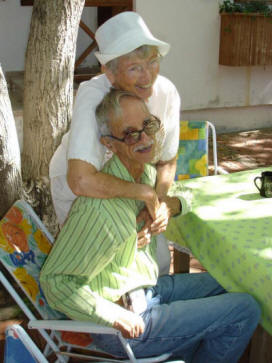 As Rotary volunteers,
Wilfred and Marie Pimentel
travel the world organizing projects and promoting what they call “integrated
solar cooking.” In this system, a solar cooker is used whenever possible, and a
fuel-efficient stove is used the rest of the time. In either case, insulated
heat-retention devices (“hay boxes”) maintain cooking temperatures after the pot
is removed from the heat source. Water pasteurization is also encouraged, using
a Water Pasteurization Indicator (WAPI) to determine when the appropriate
temperature has been reached. Since learning about solar cooking in 1988 from
Solar Cookers International, the Pimentels and the Rotary Club of Fresno,
California, have worked with local Rotary clubs to spread these skills in nearly
a dozen countries, including Armenia, Bolivia, Ghana, Kenya, Malawi, Zambia, and
Zimbabwe. They are currently working on projects in Turkey, Uganda, Rwanda, and
Mexico. In 2006 they trained 17 Peace Corps Volunteers who are promoting
integrated solar cooking in Armenia. Last year, the Fresno club joined with
Solar Household Energy (SHE) to conduct workshops in Mexico. Recently, 50 sewing
machines were purchased for solar cooking associations in Rwanda to speed the
process of making insulation for hay boxes, which are then sold for a profit.
Even youth are getting involved; over 100,000 WAPIs destined for overseas
projects have been built by high school students in Rotary Interact clubs. In a
recent on-line Rotary article, Wilfred Pimentel described the process of working
with local Rotary clubs. “We go to a country at the invitation of a Rotary club
president and ask him or her about Rotary club support, possible help from
nongovernmental organizations, and the availability of foil and cardboard needed
to make a simple cooker.” The Pimentels have been solar cooking promoters for a
long time, and show no signs of slowing down. Maybe it’s because they know how
important their message is to so many people around the world. “I've seen women
take pots out of the cooker, and the steam hits them in the face, and they can't
believe that the food is cooked,” said Marie Pimentel. “Many of the women don’t
know what Rotary is, but they take your hand in both of theirs and look at you,
and they say, ‘Thank you for coming.’” Contact: Wilfred and Marie Pimentel,
Rotary Club of Fresno, 1035 East Cambridge, Fresno, California 93704, USA. Tel:
559-222-4193, fax: 559-222-6450, e-mail: solarcook@att.net, Web:
www.integratedsolarcooking.com
As Rotary volunteers,
Wilfred and Marie Pimentel
travel the world organizing projects and promoting what they call “integrated
solar cooking.” In this system, a solar cooker is used whenever possible, and a
fuel-efficient stove is used the rest of the time. In either case, insulated
heat-retention devices (“hay boxes”) maintain cooking temperatures after the pot
is removed from the heat source. Water pasteurization is also encouraged, using
a Water Pasteurization Indicator (WAPI) to determine when the appropriate
temperature has been reached. Since learning about solar cooking in 1988 from
Solar Cookers International, the Pimentels and the Rotary Club of Fresno,
California, have worked with local Rotary clubs to spread these skills in nearly
a dozen countries, including Armenia, Bolivia, Ghana, Kenya, Malawi, Zambia, and
Zimbabwe. They are currently working on projects in Turkey, Uganda, Rwanda, and
Mexico. In 2006 they trained 17 Peace Corps Volunteers who are promoting
integrated solar cooking in Armenia. Last year, the Fresno club joined with
Solar Household Energy (SHE) to conduct workshops in Mexico. Recently, 50 sewing
machines were purchased for solar cooking associations in Rwanda to speed the
process of making insulation for hay boxes, which are then sold for a profit.
Even youth are getting involved; over 100,000 WAPIs destined for overseas
projects have been built by high school students in Rotary Interact clubs. In a
recent on-line Rotary article, Wilfred Pimentel described the process of working
with local Rotary clubs. “We go to a country at the invitation of a Rotary club
president and ask him or her about Rotary club support, possible help from
nongovernmental organizations, and the availability of foil and cardboard needed
to make a simple cooker.” The Pimentels have been solar cooking promoters for a
long time, and show no signs of slowing down. Maybe it’s because they know how
important their message is to so many people around the world. “I've seen women
take pots out of the cooker, and the steam hits them in the face, and they can't
believe that the food is cooked,” said Marie Pimentel. “Many of the women don’t
know what Rotary is, but they take your hand in both of theirs and look at you,
and they say, ‘Thank you for coming.’” Contact: Wilfred and Marie Pimentel,
Rotary Club of Fresno, 1035 East Cambridge, Fresno, California 93704, USA. Tel:
559-222-4193, fax: 559-222-6450, e-mail: solarcook@att.net, Web:
www.integratedsolarcooking.com
Solar cookers everywhere — assessing progress in Iridimi refugee camp
By Gabriele Simbriger-Williams, SCI Board Member
 In October 2007, I took part in an
evaluation of the solar cooker project in Iridimi refugee camp in Chad. Iridimi
has become the temporary shelter for 18,000 refugees driven out of their
villages in Darfur, Sudan, by Janjaweed militias and the Sudanese government.
This semi-desert region has very limited firewood resources and cannot sustain
the influx of thousands of refugees and their need for household energy. Since
the U.N. High Commissioner for Refugees (UNHCR) provides only about a third of
the refugees’ firewood needs, women and girls have to leave the camp to collect
more, exposing them to attack and rape by bandits, Janjaweed and the local
population that resents having to share its meager wood resources.
In October 2007, I took part in an
evaluation of the solar cooker project in Iridimi refugee camp in Chad. Iridimi
has become the temporary shelter for 18,000 refugees driven out of their
villages in Darfur, Sudan, by Janjaweed militias and the Sudanese government.
This semi-desert region has very limited firewood resources and cannot sustain
the influx of thousands of refugees and their need for household energy. Since
the U.N. High Commissioner for Refugees (UNHCR) provides only about a third of
the refugees’ firewood needs, women and girls have to leave the camp to collect
more, exposing them to attack and rape by bandits, Janjaweed and the local
population that resents having to share its meager wood resources.
Something needed to be done. With UNHCR approval, Derk Rijks of the Dutch KoZon Foundation started a solar cooker demonstration project in 2005. Solar Cookers International (SCI) has provided technical and financial support since the beginning. Rijks was helped by local solar cooking enthusiasts Marie-Rose Neloum and Gilhoube Patallet, who are now part of the new non-governmental organization Tchad Solaire. CooKit solar cookers were introduced in Iridimi as part of an effort to reduce reliance on scarce firewood and lessen the ecological footprint of the camp. By minimizing the need to leave camp and collect wood, refugee women are safer.
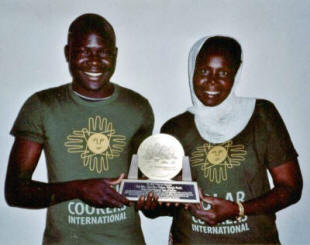 These women now earn income by manufacturing CooKits in
Iridimi and training
more women to use them. Thus far, 4700 women have been trained in solar cooking
and over 15,000 solar cookers have been distributed, two or more to every
household depending on family size. In October 2007, the security situation was
good enough that a team could visit the camp and assess the acceptance and
effectiveness of the project.
These women now earn income by manufacturing CooKits in
Iridimi and training
more women to use them. Thus far, 4700 women have been trained in solar cooking
and over 15,000 solar cookers have been distributed, two or more to every
household depending on family size. In October 2007, the security situation was
good enough that a team could visit the camp and assess the acceptance and
effectiveness of the project.
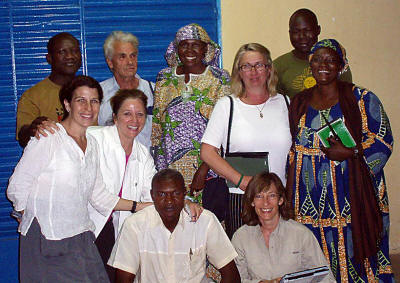 Rijks invited the project’s stakeholders —
implementers KoZon and Tchad Solaire, camp organizers/managers UNHCR and CARE,
technical/financial supporters SCI and
Jewish World Watch (JWW), improved wood
stove promoter BCI, and the Chadian Ministry of Environment — to join the
evaluation team. In total, 15 individuals from eight organizations took part.
They divided into four groups and fanned out across the camp to conduct
interviews in random households.
Rijks invited the project’s stakeholders —
implementers KoZon and Tchad Solaire, camp organizers/managers UNHCR and CARE,
technical/financial supporters SCI and
Jewish World Watch (JWW), improved wood
stove promoter BCI, and the Chadian Ministry of Environment — to join the
evaluation team. In total, 15 individuals from eight organizations took part.
They divided into four groups and fanned out across the camp to conduct
interviews in random households.
The team conducted 121 interviews during five days. Ten qualitative and quantitative questions were asked to assess the benefits and challenges of solar cooking, the usage patterns of the CooKit, and the effectiveness of the entire solar cooker project.
This assessment is especially important in view of a possible extension of the project to other refugee camps in Chad. There are 11 other camps along the Chad-Sudan border, housing more than 230,000 Darfur refugees that could benefit from simple solar cookers. Project activities are already underway in Touloum, a camp close to Iridimi with 23,000 refugees. UNHCR has expressed great interest in further expansion.
Hurtling towards Iridimi on day one in an escorted convoy with other humanitarian workers, I wondered what to expect. How many CooKits would we see? Would the women use excuses like “I used it yesterday” or “I’ll use it later,” responses I have heard many times when monitoring and evaluating improved wood stove projects. To my surprise and joy, there were CooKits everywhere! Every day as we walked through the different blocs of the camp we could see solar cookers being used. CooKits could be seen over the mud walls women constructed around their tents or mud houses. We saw cookers in alleyways between dwellings, accessible by neighbors who are asked to look over the CooKit and re-orient it if necessary while the cook is away. We even saw a CooKit being used by a shop keeper. The number of solar cookers that I personally saw in use was amazing.
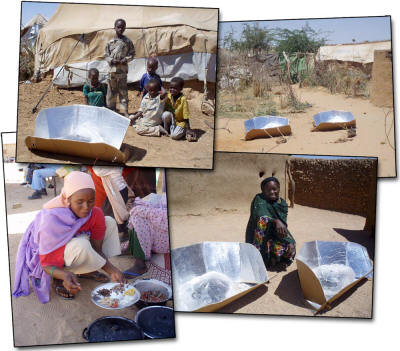 Among the key findings of the evaluation
is that all the respondents use solar cookers daily to meet the cooking needs of
their families. Sixty percent report using them twice per day, while 30 percent
use them once daily and 10 percent use them three times per day. Respondents are
able to prepare the variety of foods they are accustomed to cooking.
Among the key findings of the evaluation
is that all the respondents use solar cookers daily to meet the cooking needs of
their families. Sixty percent report using them twice per day, while 30 percent
use them once daily and 10 percent use them three times per day. Respondents are
able to prepare the variety of foods they are accustomed to cooking.
Solar cooker use is highest for the midday meal, consisting mostly of beans, lentils, or yellow peas distributed by the U.N. World Food Program. Understandably, breakfast is prepared with wood stoves. Two types of improved, fuel-efficient wood stoves are present in the camp: an improved mud stove, and a stainless steel model called the Save 80. Marking a significant change in cooking habits, very few women are using traditional three-stone fires. Evening meals are mostly cooked with improved wood stoves, but 20 percent use the CooKit in combination with a heat-retention device (“hay basket”) that allows food to continue cooking after being removed from a heat source. Since hay baskets have only been available to 25 percent of the households, it is reasonable to expect an increase in CooKit use for the evening meals with increased hay basket distribution. Solar cookers are also used for making tea, often multiple times a day.
We were eager to find out how the harsh climate was affecting solar cooking. Many women were able to use the CooKit even during the rainy season as most rain fell in the late afternoon. But the rain, dust, and strong winds have an impact on durability of the solar cookers, with 55 percent lasting as few as 2-3 months. Newer cookers have special wind and rain protection features and last longer.
The women were asked to name the benefits of solar cooking as well as to express any challenges they associate with it. Among the challenges, 25 percent expressed concern over not being able to cook in a timely manner for unexpected visitors. Only two women noted the slowness of the solar cooker as a general problem, requiring too much patience. The vast majority of women showed real acceptance of this technology, stating that the length of time it takes to solar cook doesn’t really matter since it is not time lost to tending a fire. They rather cherish it as time gained for other activities like cleaning, laundry, education, and looking more after their children, husbands, and themselves. Women and men in Iridimi also appreciate that the solar cooker project introduced them to a new technology, and gave them knowledge that they and their kids will be able to take home to Sudan one day, Inch’ Allah. As the president of the women put it: “Solar cooking is really important. It’s not for nothing that four (white) women came all the way from the USA to see us using it.”
The main advantages of the solar cookers, as stated by 80 percent of the women, include:
- Free time to do other things
- Easiness of cooking
- Absence of smoke, leading to better health (e.g., less coughing, irritated eyes, and running noses)
- Improved relations with neighbors, since disputes over wood were common
- Improved security, due to decreased need to leave camp for firewood
Before the introduction of CooKits, 71 percent of the 121 respondents left the camp to gather firewood 4-7 times a week, or nearly 450 trips. As solar cooker use spread, the number of dangerous trips was reduced drastically to 63 trips per week, a reduction of nearly 86 percent! In fact, 53 percent of the women no longer leave the camp for firewood, like the teenage girl who had her feet hit severely with stones as a painful warning not to come out there again in search of wood.
Furthermore, numerous women reported that they were able to stop selling or bartering away part of their distributed food rations just to obtain enough wood to cook the remainder. Only four women said they still buy some firewood.
During my 9-day stay in the Iridimi area, I witnessed the success and acceptance of solar cookers as part of an integrated strategy for reduced wood consumption. The refugees of Iridimi camp seem to have reaped great benefits from the solar cooker project and their solar CooKits. “There is more happiness, less violence, less insecurity,” reported the chief of a camp zone. “And I now eat three times a day.”
The results of our project assessment definitely support expansion to other camps. [Editor’s note: the full evaluation report is available on the SCI Web site at: www.solarcookers.org/programs/iridimi.html]
SCI’s Kenya program: Sunny Solutions and beyond
By Karyn Ellis, SCI Director of International Program Development
 Solar Cookers International’s
Sunny Solutions project began
in the northern region of Nyakach, Kenya in 2003, and expanded in 2005 to Kadibo,
near Lake Victoria, and just south of Nairobi in Kajiado. The project was
initiated to introduce and market affordable solar cookers to people in rural
areas. Each of these communities benefit from abundant sunshine, but what little
vegetation is available is quickly taken and used for fuel, and — as in many
areas of Africa — firewood collection is laborious, often requiring women and
girls to walk several kilometers per day. Just about every part of Kenya could
benefit from solar cooking and water pasteurization. We have our work cut out
for us.
Solar Cookers International’s
Sunny Solutions project began
in the northern region of Nyakach, Kenya in 2003, and expanded in 2005 to Kadibo,
near Lake Victoria, and just south of Nairobi in Kajiado. The project was
initiated to introduce and market affordable solar cookers to people in rural
areas. Each of these communities benefit from abundant sunshine, but what little
vegetation is available is quickly taken and used for fuel, and — as in many
areas of Africa — firewood collection is laborious, often requiring women and
girls to walk several kilometers per day. Just about every part of Kenya could
benefit from solar cooking and water pasteurization. We have our work cut out
for us.
I made my inaugural trip to Kenya last October to meet the Solar Cookers International (SCI) eastern Africa staff and become familiar with our programs there. I was fortunate to not only observe our knowledgeable staff leading demonstrations in Nairobi, but to also experience solar cooking in our most remote project areas. We traveled via four wheel drive (a necessity!) to the three project regions, meeting local women, children, and even men who cook and pasteurize water with solar CooKits on a daily basis. It was inspiring to see our programs in action, and most of the people we met were extremely enthusiastic about the benefits Sunny Solutions has brought to them.
 SCI advocates the use of solar cookers whenever feasible, but we are
often asked, “How do I cook when the sun isn’t shining?” At nighttime, or on
inclement days, SCI suggests fuel-efficient stoves that use a minimal amount of
firewood or other biomass fuel. Several types of these stoves are available in
Kenya. SCI staff and solar cooker representatives in Kenya also produce and
distribute insulated heat-retention devices (“hay baskets”) that allow food to
continue to cook after being removed from a heat source. The combination of
these complementary technologies will significantly reduce deforestation and
indoor air pollution, while giving women additional time and resources they
didn’t have before.
SCI advocates the use of solar cookers whenever feasible, but we are
often asked, “How do I cook when the sun isn’t shining?” At nighttime, or on
inclement days, SCI suggests fuel-efficient stoves that use a minimal amount of
firewood or other biomass fuel. Several types of these stoves are available in
Kenya. SCI staff and solar cooker representatives in Kenya also produce and
distribute insulated heat-retention devices (“hay baskets”) that allow food to
continue to cook after being removed from a heat source. The combination of
these complementary technologies will significantly reduce deforestation and
indoor air pollution, while giving women additional time and resources they
didn’t have before.
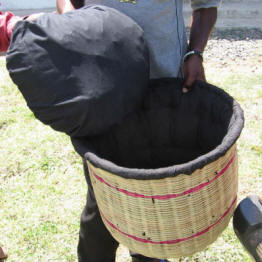 I was struck on these visits by
the number of very modest homes that had photovoltaic panels. I couldn’t believe
it: several families in these rural villages were converting solar power to
electricity, while right next door families were struggling with sooty, smoky,
hazardous paraffin lamps simply to see indoors. I am encouraged, after
witnessing broad use of solar power in some of the poorest communities in Kenya,
to look into other simple solar devices, such as flashlights and lanterns, that
can benefit those in the Sunny Solutions areas.
I was struck on these visits by
the number of very modest homes that had photovoltaic panels. I couldn’t believe
it: several families in these rural villages were converting solar power to
electricity, while right next door families were struggling with sooty, smoky,
hazardous paraffin lamps simply to see indoors. I am encouraged, after
witnessing broad use of solar power in some of the poorest communities in Kenya,
to look into other simple solar devices, such as flashlights and lanterns, that
can benefit those in the Sunny Solutions areas.
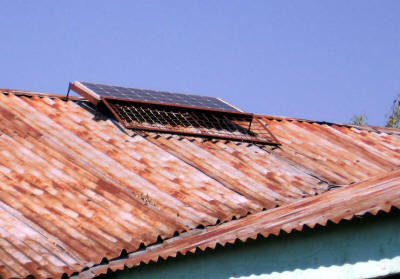 As noted in the November 2007 Solar Cooker Review, SCI has begun a safe
water project in Kenya led by SCI founder and board president Dr. Bob Metcalf, a
professor of Biological Sciences at California State University, Sacramento.
Bob’s development of a Portable Microbiology Laboratory (PML) will allow rural
health workers and community members to test water quality in the field by
assessing levels of Escherichia coli contamination. The revolutionary PML can be
used anywhere by practically anyone, and it will liberate government ministries
in charge of water analysis who have had difficulties gauging water quality in
rural areas due to travel limitations and technical expenses. Anticipated
outcomes from the project include significant reductions in the incidence of
waterborne diseases in over 20 communities, and broader community awareness of
simple and effective water testing and water pasteurization techniques. A
training is tentatively planned for this spring, with officials and
representatives from the Kenya Water Resources Management Authority and the
Kenya Ministry of Health. This is the first time that these two government
ministries have collaborated on a project like this, and we are thrilled to have
their participation and support. Major funding for this program has come from
the Richard and Rhoda Goldman Fund, for which we are very grateful!
As noted in the November 2007 Solar Cooker Review, SCI has begun a safe
water project in Kenya led by SCI founder and board president Dr. Bob Metcalf, a
professor of Biological Sciences at California State University, Sacramento.
Bob’s development of a Portable Microbiology Laboratory (PML) will allow rural
health workers and community members to test water quality in the field by
assessing levels of Escherichia coli contamination. The revolutionary PML can be
used anywhere by practically anyone, and it will liberate government ministries
in charge of water analysis who have had difficulties gauging water quality in
rural areas due to travel limitations and technical expenses. Anticipated
outcomes from the project include significant reductions in the incidence of
waterborne diseases in over 20 communities, and broader community awareness of
simple and effective water testing and water pasteurization techniques. A
training is tentatively planned for this spring, with officials and
representatives from the Kenya Water Resources Management Authority and the
Kenya Ministry of Health. This is the first time that these two government
ministries have collaborated on a project like this, and we are thrilled to have
their participation and support. Major funding for this program has come from
the Richard and Rhoda Goldman Fund, for which we are very grateful!
A new project in the works for western Kenya is the development of an SCI resource center that will offer consultations, trainings, and information resources for solar cookers and related technologies, project planning, and local environmental organizations. Unfortunately, these plans have been put on hold as a result of the political crisis that erupted in the wake of the recent presidential elections. This volatile situation, while showing light at the end of the tunnel, has disrupted current and future plans for countless organizations in Kenya, SCI included.
SCI is considering providing humanitarian assistance when things begin to settle down, similar to work we’ve done in refugee camps in Chad, Ethiopia, and elsewhere in Kenya. Over 300,000 people have been driven from their homes since the December 27 elections, and camps to house internally displaced persons (IDPs) are growing every day. As of the end of January there were over 350 spontaneous IDP camps reported in Nairobi and western Kenya alone. Organizations such as the Red Cross and United Nations have assisted by providing emergency shelter and household kits. If large numbers of people are forced to remain in these camps, SCI has the knowledge and experience to implement valuable relief through solar cooking and solar water treatment.
Dear SCI Friends,
Recently, I had the opportunity to work with Sonia Heptonstall and Joyce Jett, two of our representatives in Geneva who help to guide our advocacy program. As some of you know, Solar Cookers International (SCI) has consultative status with the U.N. Economic and Social Council (ECOSOC), which allows us to present written statements to subsidiary agencies of the United Nations and also to speak on issues such as solar cooking and water pasteurization.
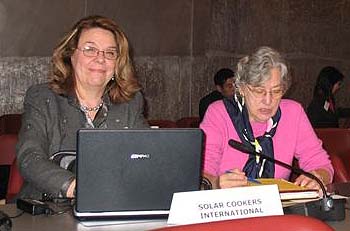 SCI is also a member of
the Conference of Nongovernmental Organizations (CONGO) that represents us
before the United Nations and helps to advocate for agenda items and discussions
to further our mission. In December we were also able to vote for the board of
directors of CONGO who will represent us until 2010.
SCI is also a member of
the Conference of Nongovernmental Organizations (CONGO) that represents us
before the United Nations and helps to advocate for agenda items and discussions
to further our mission. In December we were also able to vote for the board of
directors of CONGO who will represent us until 2010.
One of the exciting developments taking place with the United Nations is that SCI is developing a working relationship and accreditation with the World Health Organization (WHO). Three areas of compatibility between our organizations have been identified for possible program collaboration: water and sanitation, safe food handling, and family health and environment. One of the first suggestions made by WHO staff was that we consider including appropriate printed health information related to food handling and sanitation with each solar cooker. Similarly, educational materials could also be part of the packaging for the Water Pasteurization Indicator (WAPI) and water testing kits. We look forward to developing this relationship and will keep you informed.
Recent country disruptions in Kenya have imposed a temporary pull back from some of our activities abroad and a delay in starting our new safe water project (Solar Cooker Review, November 2007). However, we are pleased that all of our staff and families are well and they are anxious to get back to work. Some SCI staff in Kenya traveled to one of the camps for displaced persons outside of a police station and demonstrated solar cooking using 25 cookers. They prepared rice, cabbage, and French beans, and also pasteurized water. The message from our staff was that people in the camp were shocked that they could cook without charcoal or firewood. We will continue to work as possible in the camps using our well-trained staff.
An evaluation of the solar cooker project in Iridimi refugee camp in Chad has been completed (see “Solar cookers everywhere,” page 1). What impressed me the most about this project, in addition to the 15,000 solar cookers completed, is the decline in trips outside of the camp to look for fuel. What this means is that women face much less violence because they no longer have to risk their lives looking for fuel. This project — supported by Jewish World Watch, KoZon, Solar Cookers International and Tchad Solaire — has expanded into Touloum refugee camp, and a demonstration of solar cookers by Derk Rijks of KoZon has also taken place in Oure Cassoni, north of Iridimi.
The U.N. High Commissioner for Refugees (UNHCR) Deputy High Commissioner has expressed an interest in expanding the use of solar cookers into all camps in Chad. If this interest comes to fruition, the focus of new expansion may also be in the Farchana area to the southwest of Iridimi. For more information, including photos of this remarkable program, visit the SCI Web site: www.solarcookers.org/programs/iridimi.html. An interview with Gabriele Simbriger-Williams, SCI board member and Iridimi evaluation team member, can also be found there.
I remain optimistic about a return to stability in areas of disruption and grateful for a trained staff that can adapt their skills to meet the needs of people who are currently displaced. We are also awed by the work done by the team in Iridimi that has provided safe alternatives to cooking for more than 4,300 families living there. Thank you again for your support throughout the year. We will continue to keep you updated on the work of worldwide advocates for the use of solar energy for cooking and safe water.

Patrick T. Widner
SCI Executive Director
by Bev Blum, SCIA secretariat
The Solar Cookers International Association (SCIA) was created in July 2006 for collective actions by solar cooker experts worldwide to accelerate the spread of solar cookers to improve health, economics, societies, and environments. It appreciates the "legal umbrella" provided by Solar Cookers International (SCI), and access to its Web sites, periodicals, data banks, and United Nations consultative status to help it grow.
NO DUES FOR 2008-2009
To join or renew your yearly membership, simply:
1) Confirm or update your contact information, 2) Provide a brief summary of your solar cooker-related activities, if any (a forthcoming e-mail to members will ask for this), and 3) For those who are able, please send a donation in any amount to support collective actions. Suggested range for individuals is $15-50 (€10-35), and for organizations $50-300 (€35-200). Donations are payable by credit card or PayPal® account at solarcookers.org.
This is a good time to encourage solar cooker organizations in your part of the world to join. Together we can create visibility for your programs and commence cooperative action.
BUSY ADVOCATES
A dozen solar cooker advocates met in New York last December and volunteered for 32 tasks in 2008 related to the following: the World Health Organization; the U.N. Economic and Social Council; the U.N. Commission on Sustainable Development (CSD-16); the U.N. High Commissioner for Refugees; the U.N. Conference on Trade and Development; Practical Action; the World Bank; the Peace Corps; Cooper-Hewitt, National Design Museum (Smithsonian Institution); Green Festival (Washington, DC); and the Partnership for Clean Indoor Air (PCIA). For more details, or if you have contacts with any of the above, please contact SCI Executive Director Patrick Widner by e-mail: patrick@solarcookers.org.
TASKS FOR ALL
1) Publish summaries of your promotion work, field projects, evaluations, advocacy data, and publicity materials on the Solar Cooking Archive Wiki located at solarcooking.wikia.com; alternatively, you may e-mail them to webmaster@solarcooking.org 2) Join the PCIA (free) at www.pciaonline.org 3) Suggest student internship ideas, including data research and writing projects, to the secretariat by e-mail: association@solarcookers.org 4) Help educate your government on economic, health, and environmental benefits of solar cooker use
WHAT NEXT?
SCIA is still in its infancy. Its members include 70 independent organizations and 125 individuals from across the globe. It is exploring ways to strengthen its structure, and answers will evolve as more leaders and experts worldwide actively participate. Actions include international advocacy, regional networking such as last year's Asian meeting, and possibly future international meetings. To learn more about SCIA, contact Secretariat Bev Blum by e-mail: association@solarcookers.org
Plastic sheets may offer alternative to bags as “greenhouse” for pots
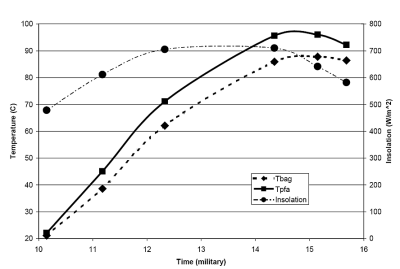 The polypropylene (PP) bags that are distributed with
CooKits in the United
States are typically reusable 10-20 times before they become brittle. More
durable alternatives have been tested over the years, including polyester sheets
with ultraviolet (UV) inhibitors, formed into bags using tape.
The polypropylene (PP) bags that are distributed with
CooKits in the United
States are typically reusable 10-20 times before they become brittle. More
durable alternatives have been tested over the years, including polyester sheets
with ultraviolet (UV) inhibitors, formed into bags using tape.
Recent studies by Dr. Dale Andreatta, a mechanical engineer, and Stephen Yen, a graduate student in electrical engineering, indicate that perfluoroalkoxy fluorocarbon (PFA) may also be a good alternative. Though expensive, PFA can withstand temperatures over 250°C and is UV stabilized.
Andreatta obtained a 60 centimeter by 60 centimeter sheet of the transparent material and tested it for transmissivity and longevity. On a clear day, the PFA sheet was nearly as transmissive as the PP bag (0.95 vs. 0.97) when perpendicular to the sun, and equally as transmissive (0.87) at a 45 degree angle. Over a testing period of several months, PP bags degraded with exposure to sunlight alone, and faster when exposed to sunlight and heat. PFA held up well across both types of exposures and appears to be much more durable than PP in typical solar cooking environments.
Andreatta performed side-by-side solar cooker tests of the plastics, in which two identical black pots were filled with equal amounts of water. One pot was placed in the standard PP bag and cinched at the open end. The other pot was wrapped with the PFA sheet as follows: the sheet was centered on the top of the pot and wrapped beneath the pot in such a way that the weight of the pot held the bottom of the sheet closed, preventing most air leaks. (Any air leaks would be under or near the bottom of the pot where little warm air escapes.) Both pots were then placed in CooKits and exposed to sunlight. Temperatures were measured throughout the day using thermocouples located approximately in the center of each pot. The cookers were re-oriented twice during the measurement period. As the graph shows, the water in the PFA-wrapped pot rose to a higher temperature faster, and held that temperature longer.
Since transmissivity of the two plastics is essentially the same, Andreatta believes that the performance difference is mostly due to volume air that surrounds the pot when placed in a bag versus wrapped with a sheet. A thin layer of air between the plastic and the pot is ideal because it insulates the pot from heat loss to ambient air. However, if the layer is too thick, air begins to circulate around the pot and convective heat loss increases. Also, heat losses to ambient air increase as the surface area of the plastic increases. Therefore, Andreatta theorizes that the PFA sheet performed better because the air layer created when the plastic sheet is wrapped around a pot (1.5 to 2.5 centimeters) is smaller than when a bag is used, as is the overall surface area of exposed plastic.
A theoretical study of heat loss confirms this. Using reasonable assumptions regarding pot temperature, and ignoring possible effects of evaporative heat transfer, Andreatta found that heat loss ranged from about 84 watts for a 1.0 centimeter air space to 115 Watts for a 10.0 centimeter air space. The bulk of the heat loss was by radiation.
Andreatta concludes that plastic sheets, wrapped carefully around pots, can be used as an alternative to plastic bags and may marginally increase performance. He also suggests that less expensive, UV-stabilized plastics may outlast PP bags even if they are not quite as heat resistant as PFA, though further tests should be conducted under actual cooking conditions.
Contact Dale Andreatta by e-mail: dandreatta@sealimited.com
SCI celebrates Margaret Owino and 10 years of devoted service
By Bev Blum, SCI founder and former executive director
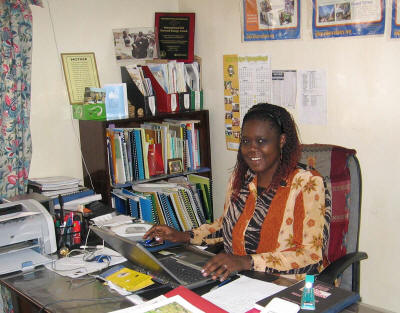 Tireless dedication … excellent professional
leadership, with kindness, humor, and patience … creative and innovative, with
persistence and grace. These all describe one of the world’s most inspiring
solar cookers leaders and advocates,
Margaret Apondi Owino.
Tireless dedication … excellent professional
leadership, with kindness, humor, and patience … creative and innovative, with
persistence and grace. These all describe one of the world’s most inspiring
solar cookers leaders and advocates,
Margaret Apondi Owino.
We celebrate Margaret’s 10th anniversary as Solar Cookers International’s regional representative and director of eastern Africa programs. Growing up in rural western Kenya, Margaret credits her mother with insisting she get a good education, including a university degree in the days when Kenya had no free public education and children had to live away from home in sometimes harsh missionary boarding schools. Margaret became a school teacher, then a school administrator. Later, after moving to Nairobi with her civil servant husband and their four sons, she developed educational materials for KENGO, a network of Kenyan energy and environmental nongovernmental organizations (NGOs).
Solar Cookers International (SCI) started work in Kenya in 1994, sponsoring two Kenyan solar cooker conferences and several teachers’ trainings for Kenyan NGOs, as well as helping to create a network of solar cooker promoters called the Kenya Solar Network (Kesonet). SCI then launched solar cooker projects in Kenya, Ethiopia, and Zimbabwe with the help of Faustine Odaba, an outstanding Kenyan trainer. Faustine learned to solar cook from a Peace Corps volunteer and had independently trained many in her western Kenya community.
 By 1998 it clearly was
time for an office in eastern Africa, and SCI was fortunate to hire Margaret to
lead and nurture these programs and the network, which evolved into Solarnet
with its own office and staff and an annual Solar Day exhibition in Nairobi.
Margaret’s first “office” was a desk in a shared room in the office of a
photovoltaic consultant / businessman. Margaret single-handedly and effectively
improved support services for SCI’s scattered field projects, and quickly became
highly respected by SCI’s many and varied partners and vendors. She also
developed training curricula and tools for participative education and program
evaluations. One of her first additional staff was Faustine, and together they
have trained women in several countries to become solar cookers trainers and
helped women to start small businesses making locally adapted, improved solar
cookers, selling them and the food and pastries baked in them. Margaret has
earned several awards for the eastern Africa office, including the prestigious
Ashden Award for Renewable Energy presented by HRH the Princess Royal. Margaret
is featured in the recent film SUNCOOKERS by Australian filmmaker Catherine
Scott.
By 1998 it clearly was
time for an office in eastern Africa, and SCI was fortunate to hire Margaret to
lead and nurture these programs and the network, which evolved into Solarnet
with its own office and staff and an annual Solar Day exhibition in Nairobi.
Margaret’s first “office” was a desk in a shared room in the office of a
photovoltaic consultant / businessman. Margaret single-handedly and effectively
improved support services for SCI’s scattered field projects, and quickly became
highly respected by SCI’s many and varied partners and vendors. She also
developed training curricula and tools for participative education and program
evaluations. One of her first additional staff was Faustine, and together they
have trained women in several countries to become solar cookers trainers and
helped women to start small businesses making locally adapted, improved solar
cookers, selling them and the food and pastries baked in them. Margaret has
earned several awards for the eastern Africa office, including the prestigious
Ashden Award for Renewable Energy presented by HRH the Princess Royal. Margaret
is featured in the recent film SUNCOOKERS by Australian filmmaker Catherine
Scott.
Margaret is equally inspiring speaking at international United Nations conferences as she is meeting with rural women whose difficult daily lives are barely on the edge of survival. SCI now has a modest but attractive independent office in Nairobi with a handful of employees, and several field staff covering one urban and three rural communities. Margaret finds ways to transcend countless challenges, and thanks to her and her excellent staff, your support of SCI is increasing access to solar cookers and empowering African women whose lives are among the heaviest-burdened in today’s world.
On behalf of these women, thank you, Margaret! And thank you, SCI supporters.
 Last summer, U.S. Congressmen Mark Udall and Zach Wamp urged their
colleagues to attend a solar cooker demonstration on Capitol Hill given by staff
and volunteers of several organizations, including Solar Cookers International
(SCI), Solar Household Energy, and Sun Ovens International.
Last summer, U.S. Congressmen Mark Udall and Zach Wamp urged their
colleagues to attend a solar cooker demonstration on Capitol Hill given by staff
and volunteers of several organizations, including Solar Cookers International
(SCI), Solar Household Energy, and Sun Ovens International.
The invitation from Udall and Wamp began as follows: “As we consider legislation and policy options on energy, the option of utilizing solar ovens, which cook food and [pasteurize] water entirely under the power of the sun, has recently come to our attention.” After citing a number of health issues related to the collection and use of biomass fuels for cooking, the Congressmen listed many societal benefits of solar cookers, including “poverty eradication … ; technology transfer; capacity building; decreased deforestation rate; energy savings and conservation; reduction in cooking fuel use; sterilization of medical instruments; and reduction in respiratory, lung, intestinal, and eye disease.”
A range of solar cookers were demonstrated, from SCI’s inexpensive CooKit to the powerful, industrial-size Village Sun Oven®. According to SCI Board Member Pat McArdle, the event drew a number of House and Senate staff members, as well as officials from the U.S. Department of Defense. The solar feast included ratatouille, squash, sweet potatoes, Cornish game hen, several types of bread and muffins, cake, and chocolate chip cookies.
Inquiries and potential collaborations have resulted from the event.
Building-integrated, non-imaging trough cooking systems
 Research architect
Joel Goodman conceptualizes ways to integrate solar
cookers into buildings. (See July 2007 Solar Cooker Review article
“Building-size CPC reflectors for the tropics.”)
Research architect
Joel Goodman conceptualizes ways to integrate solar
cookers into buildings. (See July 2007 Solar Cooker Review article
“Building-size CPC reflectors for the tropics.”)
At the heart of Goodman’s current designs for tropical, non-seismic regions, is a building-integrated system of stationary, non-imaging CPC (compound parabolic concentrator) and involute reflector “troughs” oriented in an east-west line. (Non-imaging reflectors are designed for optimal transfer of light radiation between a source and a target — in this case, the sun and cooking vessels.) The involute troughs reflect sunlight upward to the bottom of HotPots™ — custom black pots suspended inside a transparent glass bowl that creates an insulating air space around the pot.
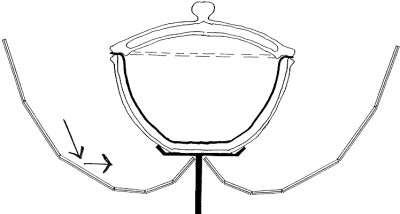 Of Goodman’s recent concepts, the least complicated to
build with earthen materials and a minimum of steel is shown in Figures 1. The involute reflector trough is a formed substrate tiled with mirror segments,
augmented with a large, one-sided stationary CPC reflector attached to the
building. (Precast trough molds could be used for multiple construction sites at
similar latitudes.) A series of HotPots are individually held in place by steel
supports (Figure 2) and easily accessible by cooks working outside the building.
Lightweight, adjustable end and front reflectors can be stored when not in use.
With a drain system, the trough acts as a rain catchment for gravity flow to
water storage.
Of Goodman’s recent concepts, the least complicated to
build with earthen materials and a minimum of steel is shown in Figures 1. The involute reflector trough is a formed substrate tiled with mirror segments,
augmented with a large, one-sided stationary CPC reflector attached to the
building. (Precast trough molds could be used for multiple construction sites at
similar latitudes.) A series of HotPots are individually held in place by steel
supports (Figure 2) and easily accessible by cooks working outside the building.
Lightweight, adjustable end and front reflectors can be stored when not in use.
With a drain system, the trough acts as a rain catchment for gravity flow to
water storage.
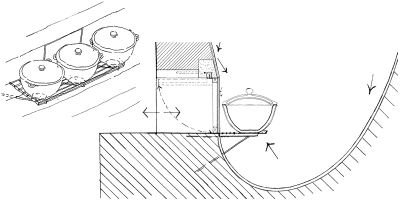 Goodman has also designed systems that don’t
require cooks to be outside. One example is the ‘thru-wall kitchen’ shown in
Figure 3. A grill attached to the outside of the building suspends HotPots in a
reflector trough. Additional sunlight comes from reflectors attached to the side
of the building. A small reflector door flap, which is part of the larger
reflective surface, allows access to up to three HotPots from within the
building. The center HotPot, directly in front of the reflector door flap, would
be pulled out first or slid onto the grill after the others are in place.
Goodman has also designed systems that don’t
require cooks to be outside. One example is the ‘thru-wall kitchen’ shown in
Figure 3. A grill attached to the outside of the building suspends HotPots in a
reflector trough. Additional sunlight comes from reflectors attached to the side
of the building. A small reflector door flap, which is part of the larger
reflective surface, allows access to up to three HotPots from within the
building. The center HotPot, directly in front of the reflector door flap, would
be pulled out first or slid onto the grill after the others are in place.
Goodman suggests that large areas of stationary reflectors can be assembled by glue-laminating mirror segments to fired clay tiles that are, in turn, tiled onto a compacted earth block structure such as an exterior wall.
Goodman invites comments and suggestions.
Contact: Joel H. Goodman, P.O. Box 14, Dodgeville, Wisconsin 53533, USA. E-mail: joelhgoodman3@hotmail.com, Web: http://solarcooking.org/Joel_Goodman.htm
Tribute gifts have been given to Solar Cookers International by:
- Susanne B. Brown in memory of Mary Ann Fiske
- C. Camy Condon in memory of Mary Ann Fiske
- Charles Hosking in memory of Mary Ann Fiske
- International Relations Center in memory of Mary Ann Fiske
- Michael and Judy Crowell in memory of Robert Newman
- Carol N. Gerlitz in memory of her husband Bill Braddock; in honor of her son, Eric S. Johnson; in honor of her sons and daughter-in-laws, Mark P. Johnson and Mary-Russell Roberson, and Kirk L. Johnson and Heather Walters
- Kathryn Landry in honor of Dr. Johnson and his family
- Judy Garrett and Town and Country Women's Club of Santa Barbara in honor of Jan Bailey
- Denice Everham in honor of Flo Everham
- Raymond and Sarah B. Hinders in honor of Howard Hudson
- Annette Howitt in honor of Amanda Turman
- Ellen Jensen in memory of Pauline Ludwig
- Florence Manne in honor of Ralph and Heather Gold
- Susan and Gregory Mansfield in honor of Jim and Cathy Dewey
- T.J. and Vivian Sarmento in honor of Tess and John Collentine
- Donald and Mabeth Wilton in honor of Lloyd Kramer
- Florence Antablin in honor of Randa and Bill Gerrity
- Matthew Watson in honor of Myrna Goldsmith
- Alfredo and Barbara Bonadeo in honor of Alessandro Bonadeo
- Patricia Chamberlin-Calamar in memory of Don Calamar
- Bernedett Jones in honor of her son Ben Jones
- Carolyn and Jim Stewart in honor of Juliet Braslow
- Mary Heinz in honor of Hank Binowski
- Teresa F. Chamiec and Don Giannini in honor of the birthday of Linda Chamiec-Case
- miyaca dawn coyote and Healing Grace Sanctuary in memory of Jim Salem
- Ann Prego in honor of her daughter Tamara Gonzalez
- Lillie and Peter Anderson in honor of Emily, Dave, Bryan, and Riley
- Chris Scammon in honor of Nancy Bancroft and Hanley Brite
- Inga Treitler and Marco and Veronica Eres in honor of Mary Frank
- Mary Carhartt in honor of Andy and Jinny Carhartt
- John and Bonnie Gault-Blue in honor of Robin Daley and Bill Kaiser
- Helen Holmberg in honor of Lynne Holmberg-Gray
- Margaret Theisen in honor of Darryl and Mary Lembke
- Dave Weller and Susan Golden in honor of Tom and Brenna Weller and family
- Cynthia W. Archer in honor of Randy Washburne
- Michael and Andrea Cassidy in honor of Fan and Jim Tucker
- Robert and Elizabeth Fisher in honor of Sally Palmer
- Hannes and Nicole Jaenicke in honor of Tina Bordihn
- Christina Ng and Frank Pao in honor of Alan Jung and Susan Lo
- Charles Parker in honor of the Parker family
- Sue Severin in honor of Rohana Mclaughlin
- E. Frances Stockman-Shaffi in honor of Dr. and Mrs. Wayne Shen
- Vicky and David Unruh in honor of Jill Kuhnheim and Theresa Shireman
- George A. Bowers in honor of Saint Clair Bourne
- Robert and Lillian Burt in honor of Will Cassilly
- Frederic and Doreen Conte in honor of Jim Coleman
- Friederike Heidger in memory of her mother Hanne Heidger-Quax
- Denise and Ervin Jindrich in honor of Ellan and Les Crosby
- Robert Castillo in honor of his parents
- Petra and Bruce Duffett in honor of Dr. and Mrs. Brad Stevens and family
- Peter Gallett in honor of Mr. and Mrs. Larry Fowler
- Carol N. Gerlitz in honor of Neil Fishman and Thomas Bollinger
- Mary D. Gordon in honor of Helen Norman Proctor
- Laura McIntosh in honor of James Schibler
- Jenny Murphy in honor of her grandfather Robert Renfer
- Nanlouise Wolfe and Stephen Zunes in honor of Matt Nathanson and Elisa Breton
- Betsy Tuller in honor of DeeDee Halleck
- Therese Collentine in honor of John Collentine
- Jessie Van Sant in honor of TamiLee Cormack and Jon Chambers
- Jessie Van Sant in honor of Christa Cormack and Shawn Mulligan
- Mr. and Mrs. Joseph Yurko in honor of their African friends
- Donaldeen M. Bera in honor of Frances R. McNeill
- Anonymous in honor of Katherine Wright
- Serena Lee in honor of “this beautiful spaceship on which we live”
- The Duchess Fund in honor of the birthday of Mary Frank
- Sally and Jack Heckscher in honor or Abigail Barber and Susan and Robert Black
Calling all U.S. federal employees!
 Are you a federal employee? Do you know one? Solar Cookers
International (SCI) has again qualified as a participating organization in the
Combined Federal Campaign (CFC). SCI is a beneficiary of the effort through the
Aid for Africa Federation. We are proud to meet the rigorous financial,
accountability, and governance standards, and ask for your CFC support.
Are you a federal employee? Do you know one? Solar Cookers
International (SCI) has again qualified as a participating organization in the
Combined Federal Campaign (CFC). SCI is a beneficiary of the effort through the
Aid for Africa Federation. We are proud to meet the rigorous financial,
accountability, and governance standards, and ask for your CFC support.
Federal employees have the option of supporting SCI with either a one-time gift or with recurring payroll deductions. For those interested in joining the effort, our CFC number is 11023. This code directs your donation to SCI’s Africa programs. If you’d like to learn more about Aid for Africa, information is available on-line at www.aidforafrica.org. Your questions are also welcomed by Michael Hayes at SCI. You can reach him by telephone: (916) 455-4499, or e-mail: michael@solarcookers.org.
Thanks, federal employees, for your philanthropy and involvement in the effort to spread this sustainable solar solution.
Solar Cookers International (SCI) has a new zip code, effective immediately: 95811-6827.
Solar Cooker Review is published two or three times per year with the purpose of presenting solar cooking information from around the world. Topics include solar cooker technology, dissemination strategies, educational materials, and cultural and social adaptations. From time to time we cover related topics such as women’s issues, wood shortages, health, nutrition, air pollution, climatic changes, and the environment.
The Review is sent to those who contribute money or news about solar cooking projects. The suggested subscription price is $10/year. Single copies are sent free to select libraries and groups overseas.
We welcome reports and commentary related to solar cooking for possible inclusion. These may be edited for clarity or space. Please cite sources whenever possible. We will credit your contribution. Send to Solar Cookers International (SCI), 1919 21st Street #101, Sacramento, California 95811-6827, USA. You may also submit by fax: +1 (916) 455-4498 or e-mail: kevin@solarcookers.org.
The Review is compiled and edited by Kevin Porter, SCI’s education resources
director, with assistance from other staff. Layout is graciously donated by
IMPACT Publications located in
SCI is a 501(c)(3) nonprofit organization assisting communities in using the power of the sun to cook food and pasteurize water for the benefit of people and environments. SCI is a member of InterAction. We do not sell, rent or trade names of our donors. Tax ID # 68-0153141.
The Review is available online at www.solarcooking.org/docs.htm#newsletters.
